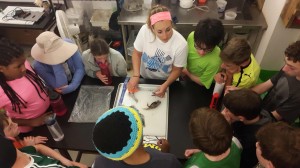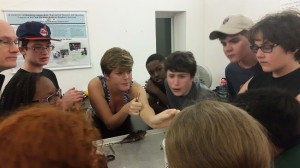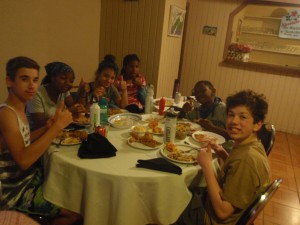
This past week, visiting students from Ohio’s Lillian and Betty Ratner School spent a week at The Island School stretching their comfort zones and exploring what it means to live sustainably while simultaneously learning about the marine life of The Bahamas. As a part of their educational experience, the Ratner students listened attentively to Dr. Jocelyn Curtis-Quick, the head of the Lionfish Research and Education Program, present on the detrimental impact of the non-native lionfish on Caribbean marine ecosystems. The students learned that these fish, originally from the Indo-Pacific, are resilient creatures that can live in environments with a wide range of salinity, depth, and habitat conditions, are seldom predated upon by Caribbean natives, and as a result are ravaging reefs by consuming native fish and invertebrates. Such intense predation impedes important ecosystems services that otherwise keep the reefs healthy and alive.

After viewing footage of bobbit worm predation in the lionfish’s native range, the school relocated to the CEI wet lab to assist Alanna and Alicia, an LREP intern and research assistant (respectively) with lionfish dissections. The students were able to point out the venomous spines of the lionfish: 13 dorsally located, 2 pelvic, and 3 anal. Once the fins were removed, the kids were enthralled with finding the heart and the otoliths of the fish, and looked on closely as the stomach was removed to check for stomach contents. Many of the students even ventured to touch the ocular lens of the eyeball as well as stick their fingers into the mouth and touch the gills.

Academic exploration did not end with the presentation and the dissection. The next night local restaurateur Sharil prepared a fried lionfish dinner for the Ratner class and each student tried a piece, even those that were initially skeptical. As a way to limit lionfish population sizes, it is important to promote spearing of the lionfish for both the tender, white fillets high in omega 3 and the beautiful jewelry that local artists make from their non-venomous fins. The students even requested a shipment of lionfish jewelry to Ohio before they left! In using every part of the fish, whether for eating or the creation of jewelry, the lionfish is used sustainably, but also removed from the ocean to create a sustainable and healthy marine ecosystem in the Caribbean. The Ratner students completed a successful trip, leaving with a bit of lionfish in their tummies and a lot of new lionfish knowledge to share with their families and friends back home.